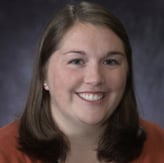n March 2020, universities across the country shut their doors to in-person learning and living situations due to potential coronavirus transmission throughout their communities. American University was no different, quickly shifting classes, events, and resources to Zoom and other virtual platforms.

While many universities had to make swift decisions–some students left for spring break and never had a chance to return–Kogod quickly called on two staff members to create a hands-on approach to learning and connecting at any distance. Assistant Dean of Online Programs Maureen Breslin and Director of Student Development and Services Andrew Toczydlowski pooled their resources and years of experience to tackle the challenge of bringing the Kogod experience online this fall.
Although American University–and many others–rolled back plans to offer limited in-person classes during the fall semester, Breslin and Toczydlowski have been steadfast in transferring on-campus opportunities online.
“With the rest of the student development team, we are ensuring that students have access to and can participate in the same co-curricular experiences they could pre-COVID,” says Toczydlowski. “Our goal is that Kogod students see little to no impact on the opportunities they can participate in.”
While Toczydlowski focuses on engagement, programming, and connecting out of the classroom, Breslin has spent the past seven months reviewing which practices of the already-successful online MBA program could be transferred to Kogod’s residential programs, all while connecting with faculty to help fold new ideas into their class formats.

“The aim was to provide faculty with structure and skills while also allowing them the freedom to adapt their academic discipline and get creative for the fall semester,” says Breslin. “Students have continued to do many of the things they’ve always done–attend office hours, work on group projects, hold study groups, participate in clubs–it’s just all happening online.”
Not all students are fully confident in an entirely online education; the novelty of the idea can be jarring. However, a recent survey reveals a growing number of individuals who favor the idea of the virtual classroom, especially among women. This may be due to several factors, but one that can’t be denied is the flexibility that online learning offers to students who may be working other jobs or caring for children.
Experts predict that we will begin to see more hybrid and entirely online learning models, even post-COVID. The main deciding factor in whether the quality of online education is on par with in-person instruction is access to technology. With the right technology, there are many benefits to online learning.
“There is no sitting in the back of the class. When on camera for a classroom conversation, the camera is literally on you, and when faculty asks a question, everyone can see the person responding,” says Breslin.
Students are held more accountable to show up, not just physically but mentally too.
“The use of chat in Zoom allows for more engagement from students in class. If a student asks a question, classmates can easily chime in and say that they have the same question or provide an answer. It means class can be livelier in exchanges,” continues Breslin. “Just because learning is online doesn’t mean it is passive, like watching Netflix. You have to engage to win and learn.”
But this is new territory for students, faculty, and staff alike. Much has been learned in the past seven months through trial and error, in addition to tried and true methods honed by past online program experiences.
“If a student sees something done really well, we want to know about it so we can implement it more broadly. The same goes for if something is not working well. We can’t address issues if we don’t know that they exist,” says Toczydlowski.
Toczydlowski and Breslin have several helpful tips for managing classwork and social obligations in this new frontier. “Time management strategies are even more important than before. Don’t just participate in class and then sign off for the day,” he says. “All campus offices are virtual, so programs, events, workshops, and more are always available to you.”
“I’d recommend thinking back to a previous semester,” adds Breslin. “When were you in a class that challenged you? What did you do to adapt? How did you change your note-taking? Reading? Listening? If you didn’t adapt, you probably continued to struggle.
“Now, what were some things you could have done differently? By zeroing in on your strengths and weaknesses and comparing them to classes this semester, you can pinpoint what you have to do to ‘level up’ and be successful.”
Students should take staff and faculty seriously when told to continue their engagement beyond “Zoom University.” An online environment does not mean checking off assignments and closing laptops. It is important for students to become involved with friends and organizations on campus.
“Read the student newsletter and seek out opportunities. Let our office know what you’re looking for. If you can’t find it, we can help you find it or create the opportunity if it doesn’t already exist!” says Toczydlowski.
Zoom fatigue is real, but the online format also opens the door to innovative ideas for upcoming class and programming formats.
“We are going to be more conscious of which types of events are more beneficial over video versus what can be simply listened to while you’re walking the dog or folding laundry,” says Toczydlowski.
As online education continues to evolve, Kogod and AU welcome students and instructors to provide feedback—a key component in ensuring an online experience that benefits everyone.
Let us know what is working or how we can improve! Email Andrew: andrew@american.edu.
